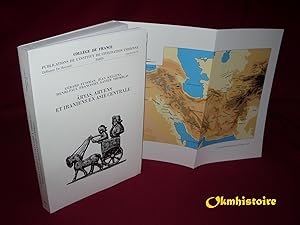2868030726 - Aryas, Aryens Et Iraniens En Asie Centrale by Gérard Fussman; Jean Kellens; Henri-paul Francfort (1 results)
Product Type
- All Product Types
- Books (1)
- Magazines & Periodicals
- Comics
- Sheet Music
- Art, Prints & Posters
- Photographs
- Maps
-
Manuscripts &
Paper Collectibles
Condition
- All Conditions
- New
- Used
Binding
- All Bindings
- Hardcover
- Softcover
Collectible Attributes
- First Edition
- Signed
- Dust Jacket
- Seller-Supplied Images
- Not Printed On Demand
Seller Location
Seller Rating
-
Aryas, Aryens et Iraniens en Asie Centrale
Published by Institut de Civilisation Indienne, 2005
ISBN 10: 2868030726ISBN 13: 9782868030726
Seller: Okmhistoire, St Rémy-des-Monts, SARTH, France
Book First Edition
Couverture souple. Condition: Comme neuf. Edition originale. Paris 2005 . 1 Volume/1. -- Comme Neuf Broché cousu. Format in-8° ( 25 x 16,6 cm )( 724 gr ). -------- 346 pages + 29 figures in-fine et une carte couleur dépliante. ***************** "" Ce volume réunit quatre études, versions développées de quelques-uns des exposés faits lors d'un séminaire organisé au Collège de France en janvier 2001 par G. Fussman et J. Kellens. X. Tremblay, dans « Grammaire comparée et grammaire historique : quelle réalité est reconstruite par la grammaire comparée ? », fait une analyse épistémologique des méthodes et résultats atteints par la grammaire comparée, en partie pour montrer aux archéologues et historiens la façon dont ils peuvent utiliser les résultats atteints par deux siècles de recherches érudites, points forts et points faibles, certitudes et spéculations. L'étude de G. Fussman, « Entre fantasmes, science et politique : l'entrée des Aryas en Inde », recense de façon critique les données et controverses contemporaines sur ce sujet. J. Kellens, dans « Les Airiia- ne sont plus des Aryas : ce sont déjà des Iraniens », étudie le mot avestique airiia-. Il montre qu'il est étroitement lié aux mythes sur l'origine des Iraniens et devrait donc être traduit par « Iranien ». Comme le védique Arya- ne désigne pas l'ensemble des populations de langue indo-aryenne entrant en Inde, Arya-/airiia- ne peut être considéré comme le nom que se donnaient, avant leur séparation, les populations de langue(s) indo-iranienne(s) et encore moins comme une appellation générique des Proto-Indo-européens. L'article de H.-P. Francfort, « La civilisation de l'Oxus et les Indo-Iraniens et Indo-Aryens », est une mise au point de première main sur ce que les archéologues anglo-saxons appellent le BMAC ( Bactro-Margian Archaeological Complex ), c'est-à-dire la civilisation matérielle et dans la mesure où on peut les restituer les croyances des peuples habitant le Turkménistan, l'Ouzbékistan du sud et l'Afghanistan du nord au moment où les Indo-Iraniens sont censés être passés dans ces territoires, devenus iraniens dès la fin du 2e millénaire avant n.è. '' ************************************************************** ********** This volume prints four papers. X. Tremblay's « Comparative grammar, historical grammar : which real facts are and can be reconstructed by comparative grammar ? » is an epistemologic study which can also be used to explain to specialists without specialized background, i-e to most of today's archaeologists and historians, which results of the comparative grammar of Indo-European languages they can safely use. G. Fussman's « Fantasms, science and politics : Aryans on their way to India » is a general survey, mainly intended for historians, of the problems and contemporary controversies. J. Kellens, in « Ir. Airiia- only means Iranian », demonstrates that Avestic airiia- is an ethnonym linked with the myths of the origins of the Iranians and indeed should be translated by « Iranian ». When Vedic Arya- is not the common name of all Indo-Aryan-speaking peoples entering India, as demonstrated long ago, and Iranian airiia- is an ethnonym specialized in the meaning « Iranian », Arya-/airiia- cannot have been the ethnic name of undivided Indo-Iranian-speaking peoples, less so of the earlier Proto-Indo-European-speaking community. H.-P. Francfort's « Oxus Civilization, or BMAC, Indo-Iranians and Indo-Aryans » begins with a first-hand survey of the common characteristics of the Oxus civilization, called by the English-writing archaeologists BMAC (Bactro-Margian Archaeological Complex), beginning c. 2500, floruit c. 2200-1750, ending c. 1500 BC., and then tries to ascertain what in it can be linked with the incoming of Indo-Iranian speaking peoples. "" ***************************** ref 327.


